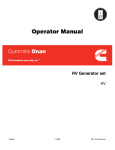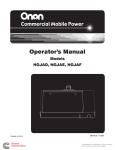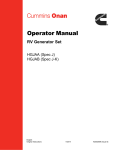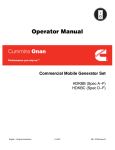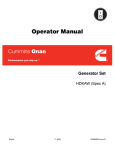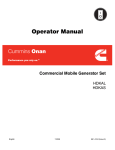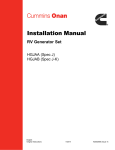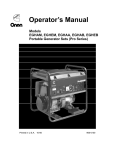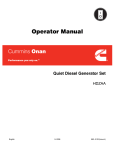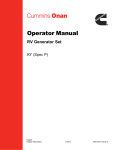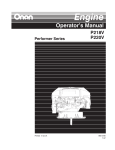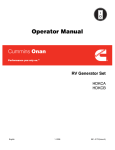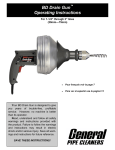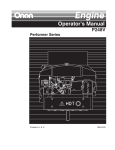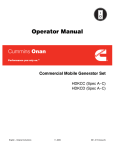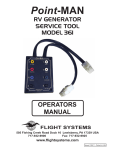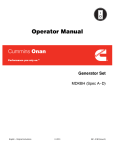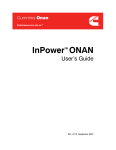Download Operator Manual - Colorado Standby LLC
Transcript
Operator Manual RV Generator Set HGJAA HGJAB HGJAC English 1−2009 983−0101 (Issue 3) ! ! The engine exhaust from this product contains chemicals known to the State of California to cause cancer, birth defects or other reproductive harm. gasoline warnings Table of Contents SAFETY PRECAUTIONS . . . . . . . . . . . . . . . . . . . . . . . . . . . . . . . . . . . . . . . . . . . . . . . . . . . . 2 INTRODUCTION . . . . . . . . . . . . . . . . . . . . . . . . . . . . . . . . . . . . . . . . . . . . . . . . . . . . . . . . . . . . 4 About this Manual . . . . . . . . . . . . . . . . . . . . . . . . . . . . . . . . . . . . . . . . . . . . . . . . . . . . . . . 4 Nameplate . . . . . . . . . . . . . . . . . . . . . . . . . . . . . . . . . . . . . . . . . . . . . . . . . . . . . . . . . . . . . . 4 Typical Genset . . . . . . . . . . . . . . . . . . . . . . . . . . . . . . . . . . . . . . . . . . . . . . . . . . . . . . . . . . 5 Fuel Recommendations . . . . . . . . . . . . . . . . . . . . . . . . . . . . . . . . . . . . . . . . . . . . . . . . . . 6 Engine Oil Recommendations . . . . . . . . . . . . . . . . . . . . . . . . . . . . . . . . . . . . . . . . . . . . . 6 Starting Batteries . . . . . . . . . . . . . . . . . . . . . . . . . . . . . . . . . . . . . . . . . . . . . . . . . . . . . . . . 6 Genset Control Panel . . . . . . . . . . . . . . . . . . . . . . . . . . . . . . . . . . . . . . . . . . . . . . . . . . . . 7 Remote Control Panel . . . . . . . . . . . . . . . . . . . . . . . . . . . . . . . . . . . . . . . . . . . . . . . . . . . . 7 OPERATION . . . . . . . . . . . . . . . . . . . . . . . . . . . . . . . . . . . . . . . . . . . . . . . . . . . . . . . . . . . . . . . . 8 Conducting Pre-Start Checks . . . . . . . . . . . . . . . . . . . . . . . . . . . . . . . . . . . . . . . . . . . . . . 8 Priming the Fuel System . . . . . . . . . . . . . . . . . . . . . . . . . . . . . . . . . . . . . . . . . . . . . . . . . . 8 Starting the Genset . . . . . . . . . . . . . . . . . . . . . . . . . . . . . . . . . . . . . . . . . . . . . . . . . . . . . . 8 Stopping the Genset . . . . . . . . . . . . . . . . . . . . . . . . . . . . . . . . . . . . . . . . . . . . . . . . . . . . . 9 Restarting the Genset . . . . . . . . . . . . . . . . . . . . . . . . . . . . . . . . . . . . . . . . . . . . . . . . . . . . 9 Loading the Genset . . . . . . . . . . . . . . . . . . . . . . . . . . . . . . . . . . . . . . . . . . . . . . . . . . . . . . 9 Resetting Circuit Breakers . . . . . . . . . . . . . . . . . . . . . . . . . . . . . . . . . . . . . . . . . . . . . . . 10 Connecting Utility Power . . . . . . . . . . . . . . . . . . . . . . . . . . . . . . . . . . . . . . . . . . . . . . . . . 10 Operating in Cold Weather . . . . . . . . . . . . . . . . . . . . . . . . . . . . . . . . . . . . . . . . . . . . . . . . 11 Operating in Hot Weather . . . . . . . . . . . . . . . . . . . . . . . . . . . . . . . . . . . . . . . . . . . . . . . . . 11 Operating at High Altitude . . . . . . . . . . . . . . . . . . . . . . . . . . . . . . . . . . . . . . . . . . . . . . . . . 11 Operating in Dusty Environments . . . . . . . . . . . . . . . . . . . . . . . . . . . . . . . . . . . . . . . . . 12 Breaking In a New Engine . . . . . . . . . . . . . . . . . . . . . . . . . . . . . . . . . . . . . . . . . . . . . . . 12 Exercising the Genset . . . . . . . . . . . . . . . . . . . . . . . . . . . . . . . . . . . . . . . . . . . . . . . . . . . 12 Storing the Genset . . . . . . . . . . . . . . . . . . . . . . . . . . . . . . . . . . . . . . . . . . . . . . . . . . . . . . 12 PERIODIC MAINTENANCE . . . . . . . . . . . . . . . . . . . . . . . . . . . . . . . . . . . . . . . . . . . . . . . . . 15 Conducting General Inspections . . . . . . . . . . . . . . . . . . . . . . . . . . . . . . . . . . . . . . . . . . 16 Checking Engine Oil Level . . . . . . . . . . . . . . . . . . . . . . . . . . . . . . . . . . . . . . . . . . . . . . . 17 Changing Engine Oil and Oil Filter . . . . . . . . . . . . . . . . . . . . . . . . . . . . . . . . . . . . . . . . 18 Maintaining Battery and Battery Connections . . . . . . . . . . . . . . . . . . . . . . . . . . . . . . . 19 Replacing the Air Filter Element . . . . . . . . . . . . . . . . . . . . . . . . . . . . . . . . . . . . . . . . . . 19 Replacing Spark Plugs . . . . . . . . . . . . . . . . . . . . . . . . . . . . . . . . . . . . . . . . . . . . . . . . . . 20 Cleaning the Spark Arrestor . . . . . . . . . . . . . . . . . . . . . . . . . . . . . . . . . . . . . . . . . . . . . . 21 TROUBLESHOOTING . . . . . . . . . . . . . . . . . . . . . . . . . . . . . . . . . . . . . . . . . . . . . . . . . . . . . . 22 SPECIFICATIONS . . . . . . . . . . . . . . . . . . . . . . . . . . . . . . . . . . . . . . . . . . . . . . . . . . . . . . . . . . 29 INFORMATION FOR CALIFORNIA GENSET USERS . . . . . . . . . . . . . . . . . . . . . . . . . . . 31 HOW TO OBTAIN SERVICE . . . . . . . . . . . . . . . . . . . . . . . . . . . . . . . . . . . . . . . . . . . . . . . . . 32 MAINTENANCE RECORD . . . . . . . . . . . . . . . . . . . . . . . . . . . . . . . . . . . . . . . . . . . . . . . . . . 33 1 Safety Precautions • Before working on the genset, disconnect the negative (−) battery cable at the battery to prevent accidental starting. Thoroughly read the OPERATOR’S MANUAL before operating the genset. Safe operation and top performance can only be obtained when equipment is operated and maintained properly. • Use caution when making adjustments while the genset is running—hot, moving or electrically live parts can cause severe personal injury or death. The following symbols in this manual alert you to potential hazards to the operator, service person and equipment. • Used engine oil has been identified by some state and federal agencies as causing cancer or reproductive toxicity. Do not ingest, inhale, or contact used oil or its vapors. alerts you to an immediate hazard which will result in severe personal injury or death. • Benzene and lead in some gasolines have been identified by some state and federal agencies as causing cancer or reproductive toxicity. Do not to ingest, inhale or contact gasoline or its vapors. alerts you to a hazard or unsafe practice which can result in severe personal injury or death. WARNING alerts you to a hazard or unsafe practice which can result in personal injury or equipment damage. CAUTION • Do not work on the genset when mentally or physically fatigued or after consuming alcohol or drugs. When equipped with an integral or add−on Auto− matic Generator Starting System (AGS) control,exhaust carbon monoxide (CO), electric shock, andmoving parts hazards are possible due to unex− pected starting. Turn off AGS whenever performingmaintenance or service, when the vehicle is storedbetween uses, is awaiting service, or is parked in agarage or other confined area. • Carefully follow all applicable local, state and federal codes. GENERATOR VOLTAGE IS DEADLY! S Disable the automatic genset starting feature(AGS) of an inverter−charger or other automatic starting device before servicing the genset to avoid electric shock from an unexpected start. Electricity, fuel, exhaust, moving parts and batteries present hazards which can result in severe personal injury or death. • Generator output connections must be made by a qualified electrician in accordance with applicable codes. GENERAL PRECAUTIONS • Make sure all fasteners are secure and torqued properly. • The genset must not be connected to the public utility or any other source of electrical power. Connection could lead to electrocution of utility personnel and damage to equipment. An approved switching device must be used to prevent interconnections. • Keep the genset and its compartment clean. Excess oil and oily rags can catch fire. Dirt and gear stowed in the compartment can restrict cooling air. • Use caution when working on live electrical equipment. Remove jewelry, make sure clothing and shoes are dry and stand on a dry wooden platform. • Keep ABC fire extinguishers handy. • Keep children away from the genset. 2 ENGINE EXHAUST IS DEADLY! accumulate under hoods and inside housings and buildings. LPG sinks when released and can accumulate inside housings and basements and other below-grade spaces. Prevent leaks and the accumulation of gas. • Learn the symptoms of carbon monoxide poisoning in this manual and never sleep in the vehicle while the genset is running unless the vehicle is equipped with a working carbon monoxide detector. BATTERY GAS IS EXPLOSIVE • The exhaust system must be installed in accordance with the genset Installation Manual. Engine cooling air must not be used for heating the working or living space or compartment. • Wear safety glasses and do not smoke while servicing batteries. • When disconnecting or reconnecting battery cables, always disconnect the negative (−) battery cable first and reconnect it last to reduce arcing. • Inspect for exhaust leaks at every startup and after every eight hours of running. • Make sure there is ample fresh air when operating the genset in a confined area. MOVING PARTS CAN CAUSE SEVERE PERSONAL INJURY OR DEATH FUEL IS FLAMMABLE AND EXPLOSIVE S Disable the automatic genset starting feature(AGS) of an inverter−charger or other automatic starting device before servicing the genset to avoid unexpected starting. • Do not smoke or turn electrical switches ON or OFF where fuel fumes are present or in areas sharing ventilation with fuel tanks or equipment. Keep flame, sparks, pilot lights, arc-producing equipment and all other sources of ignition well away. • Do not wear loose clothing or jewelry near moving parts such as PTO shafts, fans, belts and pulleys. • Fuel lines must be secured, free of leaks and separated or shielded from electrical wiring. • Keep hands away from moving parts. • Leaks can lead to explosive accumulations of gas. Natural gas rises when released and can • Keep guards in place over fans, belts, pulleys, etc. MOBILE 6 3 Introduction ABOUT THIS MANUAL This manual covers the operation and maintenance of the HGJAA, HGJAB and HGJAC Series of generator sets (gensets). Each operator should study this manual carefully and observe all of its instructions and safety precautions. Keep this manual and the Installation Manual with the other vehicle manuals. Operation, Periodic Maintenance and Troubleshooting provide the instructions necessary for operating the genset and maintaining it at top performance. The owner is responsible for performing maintenance in accordance with the PERIODIC MAINTENANCE SCHEDULE (Page 15). This manual also includes genset specifications, information on how to obtain service, and information for California users. 7HGJAA−97A D000012345 WARNING This genset is not a life support system. It can stop without warning. Children, persons with physical or mental limitations, and pets could suffer personal injury or death. A personal attendant, redundant power or an alarm system must be used if genset operation is critical. [The engine family designation, engine displacement, statement of compliance with the applicable EPA and / or California emissions regulations, including the compliance period or category, appear in this block on the actual nameplate on the genset.] NAMEPLATE RECORD NUMBERS HERE Model and Serial Numbers: Have the model and serial numbers handy (gray boxes, Figure 1) when contacting an Onan dealer for parts, service or product information. Each character is significant. (The last character of the model number is the specification letter, which is important for obtaining the right parts.) Record these numbers in the boxes in Figure 1 so that they are handy when you need them. MODEL NUMBER: SERIAL NUMBER: FIGURE 1. TYPICAL NAMEPLATE Genuine Onan replacement parts are recommended for best performance and safety. Federal Emissions Compliance Period: The Federal Emissions Compliance Period referred to on the nameplate indicates the number of operating hours for which the engine has been shown to meet Federal emissions requirements. Category C = 250 hrs, B = 500 hrs, A = 1000 hrs. 4 TYPICAL GENSET If the cover pins and rubber grommets do not line up, check that the edging on the top edge of the base tray lies flat and is pushed down all the way. Figure 2 illustrates a typical self-enclosed genset with the maintenance access cover removed. If the cover feels loose, one of the rubber grommets probably pushed through. If so, remove the cover, insert the grommet back into its hole and try again. Removing the access cover: Pull the top of the cover outward and lift it away. CAUTION Operating the genset with the access cover off can lead to overheating of components. Always secure the cover after starting the genset. Securing the access cover: Catch the bottom lip of the cover on the top edge of the base tray and firmly push it into place. CONTROL SWITCH & STATUS INDICATOR LIGHT BATTERY CABLE & REMOTE CONTROL WIRING ENTRANCE CIRCUIT BREAKERS AIR CLEANER COVER OIL FILL CAP & DIPSTICK ALTITUDE ADJUST KNOBGASOLINE, HGJAB, HGJAC OIL FILTER (ACCESS BELOW) MAINTENANCE ACCESS COVER OIL DRAIN VALVE (EXIT BELOW) FIGURE 2. TYPICAL SELF-ENCLOSED GENSET 5 RUBBER GROMMET (1 OF 2) TO SECURE ACCESS COVER PINS EDGING MUST LIE FLAT ON EDGE OF BASE TRAY FUEL RECOMMENDATIONS ENGINE OIL RECOMMENDATIONS WARNING Gasoline and LPG are highly flammable and explosive and can cause severe personal injury or death. Do not smoke or turn electrical switches ON or OFF where fuel fumes, tanks or equipment are present or in areas sharing ventilation. Keep flames, sparks, pilot lights, arc-producing equipment and switches and all other sources of ignition well away. Keep a type ABC fire extinguisher in the vehicle. Use API (American Petroleum Institute) performance Class SJ, SH or SG engine oil, which may be in combination with performance Class CH-4, CG-4 or CF-4 (for example: SJ/CH-4). Also look for the SAE (Society of Automotive Engineers) viscosity grade. Referring to Table 1, choose the viscosity grade appropriate for the ambient temperatures expected until the next scheduled oil change. Gasoline Models Single-grade SAE 30 oil is preferable when temperatures are consistently above freezing. Multigrade oils are better when wide temperature variations are expected. Use clean, fresh unleaded gasoline having a minimum octane rating (Anti-Knock Index) of 87. CAUTION Do not use gasoline or gasoline additives containing methanol because methanol can be corrosive to fuel system components. TABLE 1. OIL VISCOSITY VS. TEMPERATURE Avoid using leaded gasoline because of the extra engine maintenance that will be required. EXPECTED AMBIENT TEMPERATURES SAE VISCOSITY GRADE 32° F (0° C) and higher 30 15W-40 (OnaMaxTM) 10° F to 100° F (−12° C to 38° C) LPG Models Use clean, fresh HD-5 grade liquified petroleum gas (LPG) or equivalent product consisting of at least 90 percent propane. Commercial liquified petroleum gas fuels may contain more than 2.5 percent butane which can result in poor fuel vaporization and poor engine starting in low ambient temperatures (below 32° F (0° C). 0° F to 80° F (−18° C to 27° C) 10W-30 10W-40 −20° F to 50° F (−28° C to 10° C) 5W-30 STARTING BATTERIES The genset has a 12 volt, direct current (DC) engine cranking and control system. See Specifications (Page 29) regarding minimum battery ratings for reliable genset cranking, especially in cold weather. Also see PERIODIC MAINTENANCE SCHEDULE (Page 15) and the battery manufacturer’s instructions regarding battery maintenance. Reliable genset starting and starter service life depend upon adequate battery system capacity and proper maintenance. Satisfactory performance on low-pressure LPG models requires that the LPG vapor be supplied at a pressure within the range indicated in Specifications. WARNING High LPG supply pressure can cause gas leaks which can lead to fire and severe personal injury or death. LPG supply pressure must be adjusted to Specifications by trained and experienced personnel. OnaMax is a trademark of Onan Corporation. 6 GENSET CONTROL PANEL The genset control panel (Figure 3) is located behind the maintenance access cover (Figure 2) and has the following features: Control Switch − This switch is used to prime the fuel system, start and stop the genset and display the fault code. Hold the switch in its START position to crank and start the genset. Press the switch to its STOP position to stop the genset. Hold the switch in its STOP/PRIME position (starts in 2 seconds) to prime the fuel system (gasoline models only). See Troubleshooting (Page 22) about displaying fault codes. CONTROL SWITCH & STATUS INDICATOR LIGHT Status Indicator Light − This light is an LED (light emitting diode) in the control switch which blinks rapidly during cranking and comes on solid when the starter disconnects, indicating that the genset is running. If the genset shuts down abnormally, the light will blink a code to indicate the cause of the shutdown. See Troubleshooting (Page 22). LINE CIRCUIT BREAKERS FIGURE 3. GENSET CONTROL PANEL Line Circuit Breaker − The line circuit breaker protects the AC power leads connected to the genset from overloads and equipment short circuits. FIGURE 4. REMOTE SWITCH REMOTE CONTROL PANEL The vehicle probably has a control panel inside the vehicle for remote control of the genset. Onan offers three remote control kits as follows: • Remote switch with status indicator light only (Figure 4). • Remote switch with status indicator light and hour meter (Figure 5). • Remote switch with status indicator light and FIGURE 5. REMOTE SWITCH / HOUR METER DC voltmeter (Figure 6). The hour meter (time totalizing meter) records genset operating time in hours. It cannot be reset. See the PERIODIC MAINTENANCE SCHEDULE (Page 15). The DC voltmeter indicates whether voltage across the 12 VDC control system and battery is normal. If the indicator consistently stays above or below the normal zone, see MAINTAINING THE BATTERY AND BATTERY CONNECTIONS (Page 19). FIGURE 6. REMOTE SWITCH / DC VOLTMETER 7 Operation WARNING EXHAUST GAS IS DEADLY! Exhaust gases contain carbon monoxide, an odorless, colorless gas. Carbon monoxide is poisonous and can cause unconsciousness and death. Symptoms of carbon monoxide poisoning include: • • • Dizziness Muscular Twitching Weakness and Sleepiness • • • Throbbing in Temples Headache Inability to Think Clearly • • Nausea Vomiting IF YOU OR ANYONE ELSE EXPERIENCES ANY OF THESE SYMPTOMS, GET OUT INTO THE FRESH AIR IMMEDIATELY. If symptoms persist, seek medical attention. Shut down the genset and do not operate it until it has been inspected and repaired. Never sleep in the vehicle with the genset running unless the vehicle is equipped with a working carbon monoxide detector. Primary protection against inhaling carbon monoxide, however, is proper installation of the exhaust system, daily (every eight hour) inspection for visible and audible exhaust system leaks. CONDUCTING PRE-START CHECKS STARTING THE GENSET Start the genset from the genset control panel or remote control panel inside the vehicle (Page 7). Before the first start of the day and after every eight hours of operation, inspect the genset as instructed under CONDUCTING GENERAL INSPECTIONS (Page 16). Keep a log of maintenance and the hours run and perform any maintenance that may be due. See Returning the Genset to Service (Page 14) if the vehicle has been in storage. 1. Push and hold the switch at START until the genset starts. The status indicator light on the switch flashes while cranking. It will come on solid when the starter disconnects, indicating that the genset is running. 2. The genset control will discontinue cranking if the genset does not start within 30 seconds and will cause the status indicator light to blink Fault Code No. 4. Wait 5 seconds for the control to reset before trying again. See Troubleshooting (Page 22) if the genset does not start after two or three tries. Before each start: 1. Make sure all vehicle CO detectors are working. 2. Check for signs of fuel and exhaust leaks and for damage to the exhaust system. Do not risk burning out the starter motor by continued attempts to start. Find out why the genset is not starting and repair as necessary. CAUTION 3. Turn off the air conditioner and other large appliances. PRIMING GASOLINE FUEL SYSTEMS 3. For top performance and engine life, especially in colder weather, let the engine warm up for two minutes before connecting appliances. If a gasoline genset ran out of fuel prime the fuel system by holding the control switch at STOP/PRIME for 30 seconds. (The status indicator light will stay on solid while the pump is on.) 4. Check for fuel and exhaust leaks. Stop the genset immediately if there is a fuel or exhaust leak and have it repaired. 8 TABLE 2. TYPICAL APPLIANCE LOADS 5. See Troubleshooting (Page 22) if the engine shuts down and the status indicator light blinks. Appliance Air Conditioner Battery Charger DC Converter Refrigerator Microwave Oven Electric Frying Pan or Wok Electric Stove Element Electric Water Heater Electric Iron Electric Hair Dryer Coffee Percolator Television Radio Electric Drill Electric Broom Electric Blanket 6. Always secure the access cover after starting the genset at the genset control panel. Operating the genset with the access cover off can lead to severe burns and overheating of components. Always secure the cover after starting the genset. WARNING STOPPING THE GENSET Turn off the air conditioner and other large appliances and let the genset run for two minutes to cool down before stopping. This reduces backfiring and run-on. Then press the switch to STOP to stop the genset. RESTARTING THE GENSET See Troubleshooting (Page 22) if the genset shuts down abnormally. LOADING THE GENSET Load (watts) 1400-2000 Up to 3000 300-700 600-1000 1000-1500 1000-1500 350-1000 1000-1500 500-1200 800-1500 550-750 200-600 50-200 250-750 200-500 50-200 Note also that air density decreases as altitude increases, causing rated genset engine power to decrease—approximately 3.5 percent each increase of 1000 feet (305 m) above the maximum elevation at which the engine can maintain rated power (Table 3). It may be necessary to run fewer appliances at higher altitudes. The genset can power AC motors, air conditioners, AC/DC converters and other appliances. How much appliance load* can be powered depends upon the genset power rating. The genset will shut down or its circuit breakers will trip if the sum of the loads exceeds genset power. De-rating for temperature usually is not necessary because the engine can maintain rated power in ambient air temperatures of up to 120° F (49° C). To avoid overloading the genset and causing shutdowns, compare the sum of the loads of the appliances that are likely to be used at the same time with the power rating of the genset. Use Table 2 or the ratings on the appliances themselves (if so marked) to obtain the individual appliance loads. It may be necessary to run fewer appliances at the same time—the sum of the loads must not be greater than genset rating. TABLE 3. POWER VS. ALTITUDE Note that the genset may shut down due to overload—even though the sum of the loads is less than genset rating—when a large motor or air conditioner is started last or cycles off and then on again. The reason for this is that a motor’s startup load is much larger than its running load. It may be necessary to run fewer appliances when large motors and air conditioners are cycling on and off. Genset Rated 7.0 kW1 Genset Rated 6.5 kW1 Genset Rated 5.5 kW1 7000 watts up to 3000 ft (914 m) 6500 watts up to 3000 ft (914 m) 5500 watts up to 5000 ft (1524 m) 6755 watts @ 4000 ft (1219 m) 6272 watts @ 4000 ft (1219 m) 5307 watts @ 6000 ft (1829 m) 6510 watts @ 5000 ft (1524 m) 6044 watts @ 5000 ft (1524 m) 5114 watts @ 7000 ft (2134 m) Subtract 245 watts each additional 1000 ft (305 m) Subtract 228 watts each additional 1000 ft (305 m) Subtract 193 watts each additional 1000 ft (305 m) 1. − This table does not take into account the effect circuit breakers may have in limiting maximum genset power. Also, power decreases even though the altitude adjust knob is set correctly (Page 11). * Appliance load and genset power are measured in terms of watts (W) or kilowatts (kW), where 1 kilowatt (kW) = 1000 watts (W). 9 RESETTING CIRCUIT BREAKERS If a circuit breaker in the main power distribution panel of the vehicle or on the genset (Figure 7) trips, either a circuit shorted or too many appliances were running. Note that the genset may continue to run after a circuit breaker trips. If a circuit breaker trips, disconnect or turn off as many loads as possible and reset the circuit breaker. (Push the circuit breaker to OFF to reset it and then to ON to reconnect the circuit.) If the circuit breaker trips right away, either the electrical distribution system has a short circuit or the circuit breaker is faulty. Call a qualified electrician. If the circuit breaker does not trip, reconnect the appliances, one by one, up to a total load that does not overload the genset or cause the circuit breaker to trip. If a circuit breaker trips right away when an appliance is connected, the appliance probably has a short. LINE CIRCUIT BREAKERS FIGURE 7. LINE CIRCUIT BREAKER Electrical appliances and tools must be used and maintained properly and be properly grounded to cause the line circuit breakers to trip when short circuits occur. WARNING Short circuits in electrical appliances and tools can cause fire and electrical shock leading to severe personal injury or death. Read and follow the equipment and tool manufacturer’s instructions and warnings regarding use, maintenance and proper grounding. CONNECTING UTILITY POWER A vehicle with provisions for connecting utility power must have an approved device to keep the genset and utility from being interconnected. See the genset Installation Manual for more information. WARNING Interconnecting the genset and the public utility (or any other power source) can lead to electrocution of utility line workers, equipment damage and fire. Use an approved switching device to prevent interconnections. 10 OPERATING IN COLD WEATHER Pay particular attention to the following items when operating the genset in cold weather: 1. Make sure engine oil viscosity is appropriate for the ambient temperatures. Change oil if there is a sudden drop in temperature. See ENGINE OIL RECOMMENDATIONS (Page 6). 2. Perform spark plug maintenance (Page 20). 3. Perform battery maintenance (Page 19). 4. If so equipped, reset the carburetor for altitude (Figure 8). ALTITUDE ADJUST KNOB OPERATING IN HOT WEATHER Pay particular attention to the following items when operating the genset in hot weather: 1. Make sure nothing blocks airflow to and from the genset. 2. Make sure engine oil viscosity is appropriate for the ambient temperatures. See ENGINE OIL RECOMMENDATIONS (Page 6). 3. Keep the genset clean. 4. Perform maintenance due. See PERIODIC MAINTENANCE SCHEDULE (Page 15). 5. If so equipped, reset the carburetor for altitude (Figure 8). FIGURE 8. ALTITUDE ADJUST KNOB (SERIES HGJAB / HGJAC GASOLINE ONLY) OPERATING AT HIGH ALTITUDE Series HGJAB / HGJAC Only − For best fuel economy and genset operation reset the carburetor for the current altitude (Figure 8). Altitude may be found on road maps and road signs. For the effect of altitude on maximum power, see LOADING THE GENSET (Page 9). CAUTION Operating the genset at low altitude with a high altitude setting can cause power loss, overheating and engine damage. Always reset when returning to lower altitudes. 11 OPERATING IN DUSTY ENVIRONMENTS carburetor and removes oxides from electrical contacts and generator slip rings. The result is better starting, more reliable operation and longer engine life. Pay particular attention to the following items when operating the genset in dusty environments: 1. Do not let dirt and debris accumulate inside the genset compartment. Keep the genset clean. STORING THE GENSET 2. Perform air cleaner maintenance more often (Page 19). Proper storage is essential for preserving top genset performance and reliability when the genset cannot be exercised regularly and will be idle for more than 120 days. 3. Change engine oil every 50 hours. 4. Keep containers of engine oil that have been opened tightly closed to keep out dust. Storing Genset BREAKING IN A NEW ENGINE 1. Gasoline Models Only − Fill the fuel tank with fresh fuel and add a fuel preservative (OnaFreshTM), following the instructions on the container label. Unless a preservative (stabilizer) is added, the gasoline in the fuel system will deteriorate causing fuel system corrosion, gum formation and varnish-like deposits which can lead to hard starting and rough operation. Proper engine break-in on a new genset or on one with a rebuilt engine is essential for top engine performance and acceptable oil consumption. Run the genset at approximately 1/2 rated power for the first 1 hour and then at 3/4 rated power for 1 more hour. See LOADING THE GENSET (Page 9). Proper engine oil and oil level are especially critical during break-in because of the higher engine temperatures that can be expected. Change the oil if not appropriate for the ambient temperatures during break-in. See ENGINE OIL RECOMMENDATIONS (Page 6). Check oil level twice a day or every 4 hours during the first 20 hours of operation and change the oil after the first 20 hours of operation. Then run the genset for about 10 minutes at approximately 1/2 rated power to fill the fuel lines with the fresh fuel and preservative. WARNING Gasoline preservatives (stabilizers) are toxic. Follow the instructions on the container. Avoid skin contact. Wash hands with soap and water after using. EXERCISING THE GENSET 2. Change the engine oil (Page 18) and attach a tag indicating grade of oil viscosity (Page 6). Exercise the genset at least 1 hour each month if use is infrequent. Run the genset at approximately 1/2 rated power. See LOADING THE GENSET (Page 9). A single exercise period is better than several shorter periods. 3. Remove the air filter (Page 19) and restart the genset. While the genset is running, spray an engine fogger (OnaGardTM) into the carburetor, following the instructions on the container label, and stop the genset. The fogger leaves a protective coat of oil on the internal surfaces of the engine. Exercising a genset drives off moisture, re-lubricates the engine, replaces stale fuel in fuel lines and OnaFresh and OnaGard are trademarks of Onan Corporation. 12 4. Gasoline Models with Carburetor − Drain the carburetor float bowl (Figure 9) into a container and dispose of the fuel in accordance with local environmental regulations. Draining the float bowl prevents deposits of gum from clogging the tiny passages in the carburetor as the gasoline in the bowl evaporates during storage. 5. High Pressure LPG Models − Open the LPG oil drain valve (Figure 10) to drain the oil-like substance visible in the clear plastic drain hose. Oil-like sludge can migrate from the LPG supply system during operation, and if allowed to accumulate, can cause hard starting and rough running. The sludge drains out through the engine oil drain hose (Page 18). Make sure to reclose the valve to keep out dust and to keep the engine running smoothly. CARBURETOR FLOAT BOWL DRAIN VALVE FIGURE 9. DRAINING CARBURETOR FLOAT BOWL 6. Disconnect the battery cables (negative [−] cable first) from the starting battery and store the battery according to the battery manufacturer’s recommendations. See MAINTAINING THE BATTERY AND BATTERY CONNECTIONS (Page 19). 7. Plug the exhaust tail pipe to keep out dirt, moisture, bugs, etc. 8. Shut off the fuel supply valve (if so equipped). 9. LPG Models − Check the local ordinances if the vehicle is to be garaged. Generally, ordinances require that the LPG system be leakfree, that the LPG container not be filled beyond specified limits, that the container shutoff valve be closed and that the vehicle not be parked near sources of heat or ignition. OPEN CLOSE LPG leaks can lead to explosive accumulations in pits, sumps or other below-grade locations. Comply with all local ordinances regarding the garaging of vehicles with LPG engine fuel systems. WARNING LPG OIL DRAIN VALVE 10. Push the genset line circuit breaker OFF (Page 10). FIGURE 10. DRAINING HIGH PRESSURE LPG OF OIL 13 7. Gasoline Models − Prime the genset fuel system by holding the control switch at STOP/ PRIME for 30 seconds. (The status indicator light will stay on solid while the pump is on.) Returning Genset to Service 1. Check the oil tag on the genset and change the oil if the viscosity indicated is not appropriate for the temperatures expected. See ENGINE OIL RECOMMENDATIONS (Page 6). 8. High Pressure LPG Models − Make sure the LPG oil drain valve (Figure 10, Page 13) is closed. 2. Reconnect the starting battery (negative [−] cable last). See MAINTAINING THE BATTERY AND BATTERY CONNECTIONS (Page 19). 9. Start the genset. There may be smoke and rough operation for a few minutes until the oil from the fogger burns off. If the engine does not start, clean or replace the spark plugs, which may have been fouled by the fogger. 3. Remove the plug from the exhaust tailpipe. 4. Change the air filter element if it is dirty (Page 19). 5. Open the fuel supply valve (if so equipped). 10. Push the genset line circuit breaker ON (Page 10) when the genset is ready to power appliances. 6. Inspect the genset. See CONDUCTING GENERAL INSPECTIONS (Page 16). 14 Periodic Maintenance Periodic maintenance is essential for top performance and long genset life. Use Table 4 as a guide for normal periodic maintenance. In hot and dusty environments some maintenance procedures should be performed more frequently, as indicated by the footnotes in the table. Keeping a log of maintenance performed and hours run will help you keep genset maintenance regular and provide a basis for supporting warranty claims (Page 33). Maintenance, replacement or repair of emission control devices and systems may be performed by any engine repair establishment or individual. However, warranty work must be completed by an authorized Onan dealer. TABLE 4. PERIODIC MAINTENANCE SCHEDULE MAINTENANCE FREQUENCY MAINTENANCE PROCEDURE Every Day After First or Every 8 20 Hours Hours Every Month Every 50 Hours Every 150 Every 450 Hours Hours P a g e General Inspections X 16 Check Engine Oil Level X 17 X3 Clean and Check Battery Clean Spark Arrestor Change Engine Oil & Oil Filter 19 X X1 Replace Air Filter Element 21 X2, 3, 4 18 X2 19 Replace Spark Plugs X5 20 Clean Engine Cooling Fins X2 − Replace Fuel Filter X5, 6 − Adjust Valve Lash X6 − Clean or Replace Cylinder Heads X6 − 1 − As a part of engine break-in, change the engine oil after the first 20 hours of operation. 2 − Perform more often when operating in dusty environments. 3 − Perform more often when operating in hot weather. 4 − Perform at least once a year. 5 − Perform sooner if engine performance deteriorates. 6 − Must be performed by a qualified mechanic (authorized Onan dealer). 15 CONDUCTING GENERAL INSPECTIONS WARNING Do not park the vehicle in high grass or brush. Contact with the exhaust system can cause a fire. Inspect the genset before the first start of the day and after every eight hours of operation. Fuel System Oil Level Check for leaks at the hose, tube and pipe fittings in the fuel supply and return systems while the genset is running and while it is stopped. Do not use a flame to check for LPG leaks. Check flexible fuel hose sections for cuts, cracks, and abrasions. Make sure the fuel line is not rubbing against other parts. Replace worn or damaged fuel line parts before leaks occur. Check engine oil level (Page 17). Exhaust System Look and listen for exhaust system leaks while the genset is running. Shut down the genset if a leak is found and have it repaired before operating the genset again. Look for openings or holes between the genset compartment and vehicle cab or living space if the genset engine sounds louder than usual. Have all such openings or holes closed off or sealed to prevent exhaust gases from entering the vehicle. If you smell gas, close the LPG container shutoff valve and have the genset serviced before using it again. WARNING Gasoline and LPG are highly flammable and explosive and can cause severe personal injury or death. Shut down the genset and repair leaks immediately. Replace dented, bent or severely rusted sections of the tailpipe and make sure the tailpipe extends at least 1 inch (25.4 mm) beyond the perimeter of the vehicle. Battery Connections Park the vehicle so that genset exhaust gases disperse away from the vehicle. Barriers such as walls, snow banks, high grass and brush and other vehicles can cause exhaust gases to accumulate in and around the vehicle. Check the battery terminals for clean, tight connections. Loose or corroded connections have high electrical resistance which makes starting harder. See MAINTAINING THE BATTERY AND BATTERY CONNECTIONS (Page 19). Do not operate power ventilators or exhaust fans while the vehicle is standing with the genset running. The ventilator or fan can draw exhaust gases into the vehicle. Arcing at battery terminals or light switch or other equipment or flames and sparks can ignite battery gas causing severe personal injury—Ventilate battery area before working on or near battery—Wear safety glasses—Do not smoke—Switch trouble light ON / OFF away from battery—Do not disconnect battery cables while genset is running or vehicle battery charging system is on—Always disconnect negative (−) cable first and reconnect it last. WARNING Check all CO monitors to assure proper operation. EXHAUST GAS IS DEADLY! Do not operate the genset if there is an exhaust leak or any danger of exhaust gases entering or being drawn into the vehicle. WARNING 16 Mechanical Look for mechanical damage. Start the genset and look, listen and feel for any unusual noises and vibrations. Check the genset mounting bolts to make sure they are secure. Check to see that the genset air inlet and outlet openings are not clogged with debris or blocked. Clean accumulated dust and dirt from the genset. Do not clean the genset while it is running or still hot. Protect the generator, air cleaner, control panel, and electrical connections from water, soap and cleaning solvents. OIL FILL CAP/DIPSTICK WARNING Always wear safety glasses when using compressed air, a pressure washer or a steam cleaner to avoid severe eye injury. OIL DRAIN VALVE FIGURE 11. OIL FILL/DIPSTICK AND DRAIN VALVE CHECKING ENGINE OIL LEVEL Park the vehicle on level ground and shut off the genset before checking the engine oil level. WARNING Crankcase pressure can blow hot engine oil out the fill opening causing severe burns. Always stop the genset before removing the oil fill cap. 1. Unscrew the oil fill cap and wipe oil off the dipstick (Figure 11). Screw the cap back on, remove it and check the oil level on the dip stick. 2. Add or drain oil as necessary. See ENGINE OIL RECOMMENDATIONS (Page 6). Keep the oil level between the FULL and ADD marks. CAUTION Too much oil can cause high oil consumption. Too little oil can cause severe engine damage. Keep the oil level between the FULL and ADD marks. OIL FILLS VERY SLOWLY. TAKE YOUR TIME AND CHECK LEVEL OFTEN WHILE FILLING. IT TAKES TIME FOR THE AIR IN THE CRANKCASE TO ESCAPE AND ALLOW OIL TO ENTER. 3. Screw the oil fill cap back on securely. 17 CHANGING ENGINE OIL AND OIL FILTER 4. Spin off the old oil filter and thoroughly wipe off the filter mounting surface. Remove the old gasket if it does not come off with the filter. WARNING State and federal agencies have determined that contact with used engine oil can cause cancer or reproductive toxicity. Try to avoid skin contact and breathing of vapors. Use rubber gloves and wash exposed skin. 5. Apply a film of oil to the filter gasket and spin the new filter on by hand until the gasket just touches the mounting pad. Then turn it 1/2 to 3/4 turn—not more. Refer to Table 4 for scheduled engine oil change. Change oil more often in hot or dusty environments. 6. Refill with 2 quarts (1.8 l) of oil. See ENGINE OIL RECOMMENDATIONS (Page 6). Check and add or drain oil as necessary. 1. Place a pan underneath the oil drain hose and filter (Figure 12). Run and then stop the engine when it is warm. CAUTION Too much oil can cause high oil consumption. Too little oil can cause severe engine damage. Keep the oil level between the FULL and ADD marks. WARNING Crankcase pressure can blow hot engine oil out the fill opening causing severe burns. Always stop the genset before removing the oil fill cap. 2. Remove the oil fill cap, open the oil drain valve (Figure 11), let all oil drain from the engine and then close the drain valve. OIL FILLS VERY SLOWLY. TAKE YOUR TIME AND CHECK LEVEL OFTEN WHILE FILLING. IT TAKES TIME FOR THE AIR IN THE CRANKCASE TO ESCAPE AND ALLOW OIL TO ENTER. 3. High Pressure LPG Gensets: Drain the LPG system of accumulated oil (Item 5, Page 13). 7. Dispose of the used oil and oil filter in accordance with local environmental regulations. OIL FILTER OIL DRAIN HOSE FIGURE 12. OIL FILTER AND DRAIN HOSE—VIEW FROM BELOW OF FRONT EDGE OF GENSET 18 MAINTAINING BATTERY AND BATTERY CONNECTIONS 2. Remove battery cables with a battery terminal puller. 3. Make sure which terminal is positive (+) and which is negative (−) before making battery connections, always removing the negative (−) cable first and reconnecting it last to reduce arcing. Arcing at battery terminals or light switch or other equipment or flames and sparks can ignite battery gas causing severe personal injury—Ventilate battery area before working on or near battery—Wear safety glasses—Do not smoke—Switch trouble light ON / OFF away from battery—Do not disconnect battery cables while genset is running or vehicle battery charging system is on—Always disconnect negative (−) cable first and reconnect it last. WARNING REPLACING THE AIR FILTER ELEMENT Refer to Table 4 for scheduled air filter element replacement. In dusty environments the filter element should be inspected and changed more frequently. To change the filter element (Figure 13): 1. Unlatch the three spring clips and rotate the cover out and away from the hooks on top. Remove the air filter element. Refer to Table 4 for scheduled battery maintenance, and follow the battery manufacturer’s instructions. Have the battery charging system serviced if DC system voltage is consistently low or high. Always: 1. Keep the battery case and terminals clean and dry and the terminals tight. 2. Wipe the filter element sealing surfaces clean and reassemble the air filter with a new filter element. CARBURETOR INLET COVER FILTER ELEMENT FIGURE 13. REPLACING THE AIR FILTER ELEMENT 19 SPRING CLIPS REPLACING SPARK PLUGS plug that fouls frequently or has heavy soot deposits indicates the need for engine service. See Troubleshooting (Page 22). Refer to Table 4 for scheduled spark plug replacement. (The genset has two spark plugs, Figure 14.) The spark plugs must be in good condition for proper engine starting and performance. A spark To prevent cross threading, always thread a spark plug in by hand until it seats and then torque to 10 lbs-ft (13 N-m). SPARK PLUGS FIGURE 14. SPARK PLUGS 20 CLEANING THE SPARK ARRESTOR Refer to Table 4 for scheduled cleaning of the spark arrestor muffler. Cleaning is required for maximum genset performance. Park the vehicle away from grass, brush or debris that could be ignited by sparks expelled during this procedure. WARNING A hot muffler can cause severe burns. Let the muffler cool down before removing or installing cleanout plugs or screens. CLEANOUT PLUG Series HGJAA: A double-drum muffler is mounted inside the genset. The cleanout plug is in the top drum, but accessible from below, though not readily visible. In Figure 15 a portion of the lower drum is cut out so that the location of the plug is visible. 1. Locate the square-headed cleanout plug by hand and solidly seat a 7/16 inch, eight point, 3/8 inch drive socket wrench with 3 inch extension on the plug. Then add a swivel section and 6 inch extension and turn with a ratchet to remove the plug. FIGURE 15. HJGAA CLEANOUT PLUG—VIEW FROM BELOW 2. Start and load the genset to near full power (Page 9). Let the genset run for about five minutes to expel the soot in the muffler. 3. Stop the genset, allow the muffler to cool down and then reinstall the plug. Series HGJAB: See Figure 15 if double-drum or Figure 16 if single-drum. On a single-drum muffler the cleanout plug is accessible from below as shown in Figure 16. CLEANOUT PLUG 1. Remove the plug with a 7/16 inch, eight point socket wrench. 2. Start and load the genset to near full power (Page 9). Let the genset run for about five minutes to expel the soot in the muffler. FIGURE 16. HJGAB CLEANOUT PLUG—VIEW FROM BELOW 3. Stop the genset, allow the muffler to cool down and then reinstall the plug. Series HGJAC: The muffler is externally mounted. If it has a clean out plug like the one shown in Figure 16, use the instructions for Series HGJAB as a guide. Alternatively, the end of the tail pipe may have a spark screen (Figure 17). If so, remove the screw that secures the spark screen, clean the screen with a wire brush and re-install it. FIGURE 17. TYPICAL SPARK SCREEN 21 Troubleshooting Hot engine parts can cause severe burns. Always allow the engine time to cool before performing any maintenance or service. fault shutdown, the indicator light will repeatedly blink 2, 3 or 4 blinks at a time. TABLE 5. TROUBLESHOOTING lists the Fault Codes in numerical order along with step-by-step corrective actions. If you are unable to resolve the problem after taking the corrective actions suggested, contact an authorized Onan dealer. See How to Obtain Service (Page 32). • Three blinks indicates a service fault. Press Stop once to cause the two-digit, secondlevel fault code to blink. (Pressing Stop again will stop the blinking.)The two-digit code consists of 1, 2, 3, 4 or 5 blinks, a brief pause, and then 1 to 9 blinks. The first set of blinks represents the tens digit and the second set of blinks the units digit of the fault code number. For example, Fault Code No. 36 appears as: WARNING • Two blinks indicates a low oil pressure fault. First note the following: • Maintaining engine oil level, keeping battery connections clean and tight, watching the fuel gauge, not overloading the genset, etc. will prevent most shutdowns. blink-blink-blink—pause—blink-blink-blink-blink-blink-blink— long pause—repeat • Four blinks indicates that cranking exceeded 30 seconds without the engine starting. • When the genset and vehicle engine share a common fuel tank the fuel dip tubes are usually arranged so that the genset will run out of fuel first. Marking the genset empty point on the fuel gauge will make it easier to tell when to stop the genset before running it out of fuel. • Note: Fault Code Nos. 3 and 4 are first level faults. Avoid interpreting them as second-level Fault Code Nos. 33 and 44, which have not been assigned as fault codes. Restoring Fault Code Blinking − The fault code stops blinking after five minutes (15 minutes, Series HGJAA). Press Stop three times within five seconds to restore blinking. Note that the last fault logged will blink, even after the condition that caused the shutdown has been corrected. FAULT CODES The genset controller provides extensive diagnostics by causing the status indicator light on the Control Switch to blink in a coded fashion. Following a TABLE 5. TROUBLESHOOTING WARNING Some genset service procedures present hazards that can result in severe personal injury or death. Only trained and experienced service personnel with knowledge of fuels, electricity, and machinery hazards should perform genset service. See Safety Precautions. STATUS INDICATOR LIGHT DEAD (Faulty connections, no battery voltage) Corrective Action: 1. Try the genset Start Switch if the remote Start Switch does not work, and vice versa. 2. Clean and tighten the positive (+) and negative (−) battery cable connections at the battery, vehicle frame and genset. 3. Recharge or replace the battery. Refer to the battery manufacturer’s recommendations. 22 TABLE 5. TROUBLESHOOTING (CONT.) WARNING Some genset service procedures present hazards that can result in severe personal injury or death. Only trained and experienced service personnel with knowledge of fuels, electricity, and machinery hazards should perform genset service. See Safety Precautions. STARTING BATTERIES RUN DOWN (Marginal batteries, connections, or charging system or, parasitic loads) Corrective Action: 1. Clean and tighten the positive (+) and negative (−) battery cable connections at the battery, vehicle frame and genset. 2. Recharge or replace the battery. Refer to the battery manufacturer’s recommendations. 3. Have a battery charging system installed or serviced in the vehicle. STARTER ENGAGES-DISENGAGES (Cranking voltage dips below 6 volts—low battery charge, poor connections, long cables) Corrective Action: 1. Have the vehicle propulsion engine running while trying to start the genset—the battery charging alternator may be able to maintain starting voltage high enough to get the genset started. 2. Clean and tighten the positive (+) and negative (−) battery cable connections at the battery, vehicle frame and genset. 3. Recharge or replace the battery. Refer to the battery manufacturer’s recommendations. 4. Increase battery cable size or run parallel cables. NO POWER—GENSET RUNNING, STATUS LIGHT ON (Line circuit breaker OFF, or tripped due to short circuit or overload) Corrective Action: 1. Turn on or reset the line circuit breaker on the genset (Page 10). 2. Turn on or reset the line circuit breakers on the main distribution panel in the vehicle. LOW OIL PRESSURE FAULT—CODE NO. 2 (First-level fault code—Low oil pressure cutoff switch did not open) Corrective Action: 1. Check engine oil level and add oil as necessary (Page 17). 2. Drain excess oil (above dipstick Full mark.) SERVICE CHECK FAULT—CODE NO. 3 (First-level fault code—Indicates fault with second-level fault code) Corrective Action: Check the second-level fault code by pressing STOP once. The second-level fault code will have two-digits. The faults are listed in numerical order in this table. 23 TABLE 5. TROUBLESHOOTING (CONT.) WARNING Some genset service procedures present hazards that can result in severe personal injury or death. Only trained and experienced service personnel with knowledge of fuels, electricity, and machinery hazards should perform genset service. See Safety Precautions. OVERCRANK FAULT—CODE NO. 4 (First-level fault code—Cranking exceeded 30 seconds without engine starting) Corrective Action: 1. Gasoline Models − Check and fill the fuel tank, as necessary. (Note: The genset fuel pickup tube is probably higher up in the fuel tank than the vehicle engine pickup.) 2. Prime the engine fuel system by holding the control switch at Stop/Prime for 30 seconds. 3. Low Pressure LPG Models − Check and fill the LPG container, as necessary. On cold days the LPG container may have to be kept at least half full to provide the rate of vaporization necessary to keep up with the genset fuel demand. 4. High Pressure LPG Models − Check and fill the LPG container, as necessary, and drain the genset LPG system of oil that may have migrated from the supply system (Item 5, Page 13). Make sure to re-close the drain valve. 5. Open any closed fuel valves. 6. Secure the spark plug leads on the spark plugs (Page 20). 7. Replace the spark plugs (Page 20). 8. Service the air cleaner (Page 19). OVERVOLTAGE FAULT—CODE NO. 12 (Controller unable to maintain rated voltage) Corrective Action: See an authorized Onan dealer. UNDERVOLTAGE FAULT—CODE NO. 13 (Controller unable to maintain rated voltage) Corrective Action: Reduce the number of connected appliances, especially when air conditioners and battery chargers are running. OVERFREQUENCY FAULT—CODE NO. 14 (Engine governor unable to maintain rated frequency) Corrective Action: See an authorized Onan dealer. UNDERFREQUENCY FAULT—CODE NO. 15 (Engine governor unable to maintain rated frequency) Corrective Action: 1. Reduce the number of connected appliances, especially when air conditioners and battery chargers are running. 2. High Pressure LPG Models − Drain the genset LPG system of oil that may have migrated from the supply system (Item 5, Page 13). Make sure to re-close the drain valve. 24 TABLE 5. TROUBLESHOOTING (CONT.) WARNING Some genset service procedures present hazards that can result in severe personal injury or death. Only trained and experienced service personnel with knowledge of fuels, electricity, and machinery hazards should perform genset service. See Safety Precautions. GOVERNOR ACTUATOR FAULT—CODE NO. 19 (Controller sensed open or shorted circuit) Corrective Action: See an authorized Onan dealer. GOVERNOR ACTUATOR OVERLOAD FAULT—CODE NO. 22 (Duration of operation at or near full-duty cycle beyond design limit) Corrective Action: 1. Reduce the number of connected appliances, especially when air conditioners and battery chargers are running. 2. Service the air cleaner (Page 19). 3. Check for and repair a blocked exhaust system. LOW OIL PRESSURE CUTOFF SWITCH FAULT—CODE NO. 23 (Controller sensed switch still open during start—not a running fault) Corrective Action: See an authorized Onan dealer. VOLTAGE SENSE FAULT—CODE NO. 27 (Controller unable to sense output voltage) Corrective Action: See an authorized Onan dealer. HIGH BATTERY VOLTAGE FAULT—CODE NO. 29 (Voltage across battery system greater than 19 volts) Corrective Action: 1. Check battery bank connections and reconnect if necessary so that the 12 volt batteries serving the genset are connected in parallel (12 volt) rather than in series (24 volt). 2. Select a lower battery boost charge rate. OVERSPEED FAULT—CODE NO. 31 (Engine speed greater than 3400 rpm) Corrective Action: See an authorized Onan dealer. 25 TABLE 5. TROUBLESHOOTING (CONT.) WARNING Some genset service procedures present hazards that can result in severe personal injury or death. Only trained and experienced service personnel with knowledge of fuels, electricity, and machinery hazards should perform genset service. See Safety Precautions. LOW CRANKING SPEED FAULT—CODE NO. 32 (Cranking speed less than 180 rpm for more than 2 seconds) Corrective Action: 1. Clean and tighten the positive (+) and negative (−) battery cable connections at the battery and at the genset. 2. Recharge or replace the battery. Refer to the battery manufacturer’s recommendations. 3. Replace engine oil with oil of proper viscosity for ambient temperatures (Page 6). (High oil viscosity can slow down cranking speed.) CONTROL CARD FAILURE FAULT—CODE NO. 35 (Microprocessor EEPROM error during self-test) Corrective Action: See an authorized Onan dealer. ENGINE STOPPED FAULT—CODE NO. 36 (Engine stopped without command by controller) Corrective Action: 1. Gasoline Models − Check and fill the fuel tank, as necessary. (Note: The genset fuel pickup tube is probably higher up in the fuel tank than the vehicle engine pickup.) 2. Low Pressure LPG Models − Check and fill the LPG container, as necessary. On cold days the LPG container may have to be kept at least half full to provide the rate of vaporization necessary to keep up with the genset fuel demand. 3. High Pressure LPG Models − Check and fill the LPG container, as necessary, and drain the genset LPG system of oil that may have migrated from the supply system (Item 5, Page 13). Make sure to re-close the drain valve. 4. Secure the spark plug leads on the spark plugs (Page 20). 5. Replace the spark plugs (Page 20). 6. Service the air cleaner (Page 19). 7. Check for mechanical damage. INVALID GENSET CONFIGURATION FAULT—CODE NO. 37 (Wrong frequency/rpm ratio) Corrective Action: See an authorized Onan dealer. 26 TABLE 5. TROUBLESHOOTING (CONT.) WARNING Some genset service procedures present hazards that can result in severe personal injury or death. Only trained and experienced service personnel with knowledge of fuels, electricity, and machinery hazards should perform genset service. See Safety Precautions. OVERCURRENT (FIELD OVERLOAD) FAULT—CODE NO. 38 (Low power factor loads) Corrective Action: 1. Reduce the number of appliances running at the same time, especially those with high motor starting loads such as air conditioners. 2. Have air conditioners and other appliances checked for proper operation. (A locked compressor rotor can cause very low power factor.) GENERATOR ROTOR FAULT—CODE NO. 41 (Controller unable to sense field or output voltage) Corrective Action: See an authorized Onan dealer. PROCESSOR FAULT—CODE NO. 42 (Microprocessor ROM error during self-test) Corrective Action: See an authorized Onan dealer. PROCESSOR FAULT—CODE NO. 43 (Microprocessor RAM error during self-test) Corrective Action: See an authorized Onan dealer. SPEED SENSE FAULT—CODE NO. 45 (Controller unable to sense quadrature frequency) Corrective Action: See an authorized Onan dealer. IGNITION FAULT—CODE NO. 47 (Controller unable to sense ignition) Corrective Action: See an authorized Onan dealer. GENERATOR FIELD SENSE FAULT—CODE NO. 48 (Controller unable to sense field voltage) Corrective Action: See an authorized Onan dealer. 27 TABLE 5. TROUBLESHOOTING (CONT.) WARNING Some genset service procedures present hazards that can result in severe personal injury or death. Only trained and experienced service personnel with knowledge of fuels, electricity, and machinery hazards should perform genset service. See Safety Precautions. PROCESSOR FAULT—CODE NO. 51 (Microprocessor malfunction) Corrective Action: See an authorized Onan dealer. FUEL INJECTOR FAULT—CODE NO. 52 (Open or short circuit in fuel injector) Corrective Action: See an authorized Onan dealer. MAT SENDER FAULT—CODE NO. 54 (Open or short circuit in MAT sender) Corrective Action: See an authorized Onan dealer. MAP SENDER FAULT—CODE NO. 56 (Open or short circuit in MAP sender) Corrective Action: See an authorized Onan dealer. OVERPRIME FAULT—CODE NO. 57 (Prime mode exceeded 3 minutes) Corrective Action: Check for and remove any object that may be holding either control switch (remote or local) in the prime position. 28 Specifications GASOLINE MODELS 7.0 HGJAA 7.0 HGJAB 7.0 HGJAC 5.5 HGJAA 5.5 HGJAB 5.5 HGJAC GENERATOR: 2-Pole Revolving Field, 2-Bearing, Self-Excited, 1-Phase, Vertical Shaft, Capped Digital Voltage Regulation Power 7000 watts 5500 watts Frequency 60 Hertz 60 Hertz Voltage 120 volts 120 volts Current 58.3 amp 45.8 amp Speed 3600 rpm 3600 rpm FUEL CONSUMPTION: No load 0.43 gph (1.6 l/h) 0.43 gph (1.6 l/h) 0.43 gph (1.6 l/h) 0.34 gph (1.3 l/h) 0.35 gph (1.3 l/h) 0.35 gph (1.3 l/h) Half load 0.70 gph (2.7 l/h) 0.73 gph (2.8 l/h) 0.73 gph (2.8 l/h) 0.58 gph (2.2 l/h) 0.60 gph (2.3 l/h) 0.60 gph (2.3 l/h) Full load 1.13 gph (4.3 l/h) 1.22 gph (4.6 l/h) 1.22 gph (4.6 l/h) 0.89 gph (3.4 l/h) 0.95 gph (3.6 l/h) 0.95 gph (3.6 l/h) ENGINE: Air-Cooled, 4-Cycle Spark-Ignited, OHV, 90° V Twin Cyl, Vertical Shaft Fueling Method Governor SFI1 Carburetor Carburetor SFI1 Carburetor Carburetor Digital Mechanical Mechanical Digital Mechanical Mechanical Speed 2880 rpm 2400 rpm Bore 3.15 in (80 mm) 3.15 in (80 mm) Stroke 2.56 in (65 mm) 2.56 in (65 mm) Displacement 39.8 in3 39.8 in3 (653 cc) (653 cc) Comp. Ratio 8.0 : 1 8.0 : 1 Oil Capacity 2.0 quart (1.8 l) 2.0 quart (1.8 l) 0.004 in (0.10 mm), Intake & Exhaust 0.004 in (0.10 mm), Intake & Exhaust 18−25 lbs-ft (23−32 N-m) 18−25 lbs-ft (23−32 N-m) 20° BTDC, non-adjustable magneto 20° BTDC, non-adjustable magneto Valve Lash (Cold) Spark Plug Ignition Timing Magneto Air Gap 0.012 in (0.3 mm) 0.012 in (0.3 mm) Spark Plug Gap 0.025 in (6-7 mm) 0.025 in (6-7 mm) DC SYSTEM: Battery Voltage Min. Battery CCA 12 volts 12 volts 450 @ 0° F (−18° C) 450 @ 0° F (−18° C) INSTALLATION: Exhaust O. D. Max. Exhaust Back Pressure 1-1/4 in 1-1/4 in − − 35 in (889 mm) WC Fuel Supply Connection 5/16 in. SAE J1231 Type 1 1/4 in. SAE J1231 Type 1 1/4 in. SAE J1231 Type 1 5/16 in. SAE J1231 Type 1 1/4 in. SAE J1231 Type 1 1/4 in. SAE J1231 Type 1 Fuel Return Connection 1/4 in. SAE J1231 Type 1 − − 1/4 in. SAE J1231 Type 1 − − Noise dB(A)2 Weight Compartment (H x D x W)3 − − 35 in (889 mm) WC 65 67 75 64 66 74 290 lb (132 Kg) 290 lb (132 Kg) 239 lb (107 Kg) 279 lb (127 Kg) 279 lb (127 Kg) 228 lb (104 Kg) HGJAA/HGJAB: 17.2 in x 23.2 in x 34.6 in (438 mm x 589 mm x 879 mm) HGJAC: 16.5 in x 22.8 in x 27.9 in (420 mm x 579 mm x 709 mm) 1.Sequential Multiport Fuel Injection 2.Measurements @ 10 ft (3 m) in a typical RV installation, under an 4 kW load. 3.With 1/2 in. clearances. See the Installation Manual for additional considerations when sizing the genset compartment. 29 LPG MODELS 6.5 HGJAA 6.5 HGJAB 6.5 HGJAC 5.5 HGJAA 5.5 HGJAB 5.5 HGJAC GENERATOR: 2-Pole Revolving Field, 2-Bearing, Self-Excited, 1-Phase, Vertical Shaft, Capped Digital Voltage Regulation Power 6500 watts 5500 watts Frequency 60 Hertz 60 Hertz Voltage 120 volts 120 volts Current 54.2 amp 45.8 amp Speed 3600 rpm 3600 rpm FUEL CONSUMPTION: No load 2.2 lbs/h (1.0 kg/h) 2.2 lbs/h (1.0 kg/h) 2.2 lbs/h (1.0 kg/h) 1.8 lbs/h (0.8 kg/h) 1.8 lbs/h (0.8 kg/h) 1.8 lbs/h (0.8 kg/h) Half load 3.9 lbs/h (1.8 kg/h) 3.9 lbs/h (1.8 kg/h) 3.9 lbs/h (1.8 kg/h) 3.3 lbs/h (1.5 kg/h) 3.3 lbs/h (1.5 kg/h) 3.3 lbs/h (1.5 kg/h) Full load 5.3 lbs/h (2.4 kg/h) 5.3 lbs/h (2.4 kg/h) 5.3 lbs/h (2.4 kg/h) 4.6 lbs/h (2.1 kg/h) 4.6 lbs/h (2.1 kg/h) 4.6 lbs/h (2.1 kg/h) ENGINE: Air-Cooled, 4-Cycle Spark-Ignited, OHV, 90° V Twin Cyl, Vertical Shaft Fueling Method Air/Fuel Mixer Air/Fuel Mixer Mechanical Mechanical 2880 rpm 2400 rpm Bore 3.15 in (80 mm) 3.15 in (80 mm) Stroke 2.56 in (65 mm) 2.56 in (65 mm) Displacement 39.8 in3 (653 cc) 39.8 in3 (653 cc) Governor Speed Comp. Ratio 8.0 : 1 8.0 : 1 Oil Capacity 2.0 quart (1.8 l) 2.0 quart (1.8 l) 0.004 in (0.10 mm), Intake & Exhaust 0.004 in (0.10 mm), Intake & Exhaust Valve Lash (Cold) Spark Plug Ignition Timing 18−25 lbs-ft (23−32 N-m) 18−25 lbs-ft (23−32 N-m) 20° BTDC, non-adjustable magneto 20° BTDC, non-adjustable magneto Magneto Air Gap 0.012 in (0.3 mm) 0.012 in (0.3 mm) Spark Plug Gap 0.025 in (6-7 mm) 0.025 in (6-7 mm) DC SYSTEM: Battery Voltage Min. Battery CCA 12 volts 12 volts 450 @ 0° F (−18° C) 450 @ 0° F (−18° C) INSTALLATION: Exhaust O. D. Max. Exhaust Back Pressure 1-1/4 in − 1-1/4 in 35 in (889 mm) WC − − 35 in (889 mm) WC − LPG Vapor: Connection Pressure 3/8−18 NPTF 9-13 in (228-330 mm) WC 3/8−18 NPTF 9-13 in (228-330 mm) WC LPG Liquid: Connection Pressure 1/4−18 NPTF Tank Pressure 1/4−18 NPTF Tank Pressure Noise dB(A)1 Weight Compartment (H x D x W)2 65 67 75 64 67 74 290 lb (132 Kg) 290 lb (132 Kg) 239 lb (107 Kg) 279 lb (127 Kg) 279 lb (127 Kg) 228 lb (104 Kg) HGJAA/HGJAB: 17.2 in x 23.2 in x 34.6 in (438 mm x 589 mm x 879 mm) HGJAC: 16.5 in x 22.8 in x 27.9 in (420 mm x 579 mm x 709 mm) 1.Measurements @ 10 ft (3 m) in a typical RV installation, under an 4 kW load. 2.With 1/2 in. clearances. See the Installation Manual for additional considerations when sizing the genset compartment. 30 Information for California Genset Users This genset meets the requirements of California’s Exhaust Emissions Standards as stated on the nameplate. Figure 1 (Page 4) illustrates where this information appears on the nameplate. You should carefully review Operator (Owner), Installation and other manuals and information you receive with your genset. If you are unsure that the installation, use, maintenance or service of your genset is authorized, you should seek assistance from an approved Onan dealer. As a California user of this genset, please be aware that unauthorized modifications or replacement of fuel, exhaust, air intake, or speed control system components that affect engine emissions are proCalifornia genset users may use Table 6 as an aid in hibited. Unauthorized modification, removal or relocating information related to the California Air Replacement of the genset label is prohibited. sources Board requirements for emissions control. TABLE 6. EMISSIONS CONTROL INFORMATION Genset Warranty Information The California emissions control warranty statement is located in the same packet of information as this manual when the genset is shipped from the factory. Engine Valve Lash See Specifications (Page 29). Engine Ignition Timing See Specifications (Page 29). Engine Fuel Requirements Engine Lubricating Oil Requirements Engine Fuel Mixture Settings Gasoline Models: The engine is certified to operate on unleaded gasoline. See Fuel Recommendations (Page 6). LPG Models: The engine is certified to operate on LPG. See Fuel Recommendations (Page 6). See ENGINE OIL RECOMMENDATIONS (Page 6). Gasoline Models—Fuel Injection: The precision-manufactured fuel injection system is not adjustable. All Other Models: The precision-manufactured carburetor is not adjustable. Gasoline Models—Fuel Injection: Not applicable Engine Adjustments Gasoline Models—Carburetor: See Figure 8 (Page 11). LPG Models: Not applicable. Engine Emission Control System Gasoline Models—Fuel Injection: The engine emissions control system consists of Sequential Multiport Fuel Injection (SFI). All Other Models: The engine emissions control system consists of internal engine design. 31 How to Obtain Service When you need service, parts, or product literature (such as the Service Manual) for your genset, contact the nearest authorized distributor. Onan has factory-trained representatives to handle your needs for genset parts and service. 4:00 PM, Central Standard Time, Monday through Friday, or fax 1−763−528−7229. Call 1-800-888-ONAN to contact the nearest Cummins/Onan or Onan-only distributor in the United States or Canada. (This automated service utilizes touch-tone phones only). Select OPTION 1 (press 1) to be automatically connected to the distributor nearest to you. 1. The complete genset model number and serial number. See Model Identification (Page 4). If you are unable to contact a distributor using the automated service, consult the Yellow Pages. Typically, our distributors are listed under: If you have difficulty in arranging service or resolving a problem, please contact the Service Manager at the nearest Cummins/Onan distributor for assistance. Before calling for service, have the following information available: 2. The date of purchase. 3. The nature of the problem. See Troubleshooting (Page 22). GENERATORS − ELECTRIC, ENGINES − GASOLINE OR DIESEL, or RECREATIONAL VEHICLES − EQUIPMENT, PARTS AND SERVICE. Improper service or replacement of parts can result in severe personal injury, death, and/or equipment damage. Service personnel must be trained and experienced in performing electrical and/or mechanical service. WARNING If you are outside North America, call Onan Corporation at 1−763−574−5000 from 7:30 AM to 32 Maintenance Record Record all periodic and unscheduled maintenance and service. See Periodic Maintenance (Page 15). DATE HOUR METER READING MAINTENANCE OR SERVICE PERFORMED Record the name, address, and phone number of your authorized Onan service center. 33 Cummins Power Generation 1400 73rd Ave. NE Minneapolis, MN 55432 USA Phone 1 763 574 5000 Toll-free 1 800 888 6626 Fax 1 763 574 5298 Email www.cumminsonan.com/contact www.cumminsonan.com CumminsR, OnanR, the “C” logo, and “Performance you rely on.” are trademarks of Cummins Inc. E2009 Cummins Power Generation, Inc. All rights reserved.




































